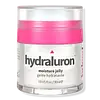What's inside
What's inside
 Key Ingredients
Key Ingredients

 Benefits
Benefits

 Concerns
Concerns

No concerns
 Ingredients Side-by-side
Ingredients Side-by-side

Water
Skin ConditioningGlycerin
HumectantPentylene Glycol
Skin ConditioningGlycereth-26
HumectantCarbomer
Emulsion StabilisingGlyceryl Polyacrylate
Trehalose
HumectantUrea
BufferingStrelitzia Nicolai Seed Aril Extract
Skin ConditioningSodium Hydroxide
BufferingDisodium EDTA
Serine
MaskingBiosaccharide Gum-1
HumectantAlgin
MaskingDisodium Phosphate
BufferingPullulan
Sodium Hyaluronate
HumectantPotassium Phosphate
BufferingCaprylyl Glycol
EmollientPhenoxyethanol
PreservativeWater, Glycerin, Pentylene Glycol, Glycereth-26, Carbomer, Glyceryl Polyacrylate, Trehalose, Urea, Strelitzia Nicolai Seed Aril Extract, Sodium Hydroxide, Disodium EDTA, Serine, Biosaccharide Gum-1, Algin, Disodium Phosphate, Pullulan, Sodium Hyaluronate, Potassium Phosphate, Caprylyl Glycol, Phenoxyethanol
Water
Skin ConditioningGlycerin
HumectantDicaprylyl Ether
EmollientPanthenol
Skin Conditioning1,2-Hexanediol
Skin ConditioningHexyldecyl Laurate
EmollientHexyldecanol
EmollientDipropylene Glycol
HumectantEclipta Prostrata Leaf Extract
Skin ConditioningLaminaria Japonica Extract
Skin ProtectingButylene Glycol
HumectantHydroxyacetophenone
AntioxidantTromethamine
BufferingCentella Asiatica Extract
CleansingEthylhexylglycerin
Skin ConditioningHydrogenated Lecithin
EmulsifyingPolyquaternium-51
Skin ConditioningFructooligosaccharides
HumectantXanthan Gum
EmulsifyingBeta-Glucan
Skin ConditioningFicus Carica Fruit Extract
HumectantSolanum Melongena Fruit Extract
Skin ConditioningAmmonium Acryloyldimethyltaurate/Vp Copolymer
Carbomer
Emulsion StabilisingHydrolyzed Hyaluronic Acid
HumectantLonicera Japonica Flower Extract
Skin ConditioningForsythia Suspensa Fruit Extract
AntioxidantCnidium Officinale Root Extract
Skin ConditioningCoptis Japonica Root Extract
Skin ConditioningGardenia Jasminoides Fruit Extract
Cosmetic ColorantAngelica Gigas Root Extract
Skin ConditioningHouttuynia Cordata Extract
Skin ConditioningGlycyrrhiza Uralensis Root Extract
Skin ConditioningCeramide NP
Skin ConditioningTocopherol
AntioxidantPentylene Glycol
Skin ConditioningWater, Glycerin, Dicaprylyl Ether, Panthenol, 1,2-Hexanediol, Hexyldecyl Laurate, Hexyldecanol, Dipropylene Glycol, Eclipta Prostrata Leaf Extract, Laminaria Japonica Extract, Butylene Glycol, Hydroxyacetophenone, Tromethamine, Centella Asiatica Extract, Ethylhexylglycerin, Hydrogenated Lecithin, Polyquaternium-51, Fructooligosaccharides, Xanthan Gum, Beta-Glucan, Ficus Carica Fruit Extract, Solanum Melongena Fruit Extract, Ammonium Acryloyldimethyltaurate/Vp Copolymer, Carbomer, Hydrolyzed Hyaluronic Acid, Lonicera Japonica Flower Extract, Forsythia Suspensa Fruit Extract, Cnidium Officinale Root Extract, Coptis Japonica Root Extract, Gardenia Jasminoides Fruit Extract, Angelica Gigas Root Extract, Houttuynia Cordata Extract, Glycyrrhiza Uralensis Root Extract, Ceramide NP, Tocopherol, Pentylene Glycol
 Reviews
Reviews

Ingredients Explained
These ingredients are found in both products.
Ingredients higher up in an ingredient list are typically present in a larger amount.
Carbomer is a polymer of acrylic acid. Its main role is to create a gel consistency.
A high amount of carbomer can cause pilling or balling up of products. Don't worry, most products contain 1% or less of carbomer.
Glycerin is already naturally found in your skin. It helps moisturize and protect your skin.
A study from 2016 found glycerin to be more effective as a humectant than AHAs and hyaluronic acid.
As a humectant, it helps the skin stay hydrated by pulling moisture to your skin. The low molecular weight of glycerin allows it to pull moisture into the deeper layers of your skin.
Hydrated skin improves your skin barrier; Your skin barrier helps protect against irritants and bacteria.
Glycerin has also been found to have antimicrobial and antiviral properties. Due to these properties, glycerin is often used in wound and burn treatments.
In cosmetics, glycerin is usually derived from plants such as soybean or palm. However, it can also be sourced from animals, such as tallow or animal fat.
This ingredient is organic, colorless, odorless, and non-toxic.
Glycerin is the name for this ingredient in American English. British English uses Glycerol/Glycerine.
Learn more about GlycerinPentylene glycol is typically used within a product to thicken it. It also adds a smooth, soft, and moisturizing feel to the product. It is naturally found in plants such as sugar beets.
The hydrophilic trait of Pentylene Glycol makes it a humectant. As a humectant, Pentylene Glycol helps draw moisture from the air to your skin. This can help keep your skin hydrated.
This property also makes Pentylene Glycol a great texture enhancer. It can also help thicken or stabilize a product.
Pentylene Glycol also acts as a mild preservative and helps to keep a product microbe-free.
Some people may experience mild eye and skin irritation from Pentylene Glycol. We always recommend speaking with a professional about using this ingredient in your routine.
Pentylene Glycol has a low molecular weight and is part of the 1,2-glycol family.
Learn more about Pentylene GlycolWater. It's the most common cosmetic ingredient of all. You'll usually see it at the top of ingredient lists, meaning that it makes up the largest part of the product.
So why is it so popular? Water most often acts as a solvent - this means that it helps dissolve other ingredients into the formulation.
You'll also recognize water as that liquid we all need to stay alive. If you see this, drink a glass of water. Stay hydrated!
Learn more about Water